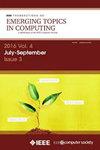时间序列分类的混合量子ResNet
IF 5.4
2区 计算机科学
Q1 COMPUTER SCIENCE, INFORMATION SYSTEMS
IEEE Transactions on Emerging Topics in Computing
Pub Date : 2025-04-30
DOI:10.1109/TETC.2025.3563944
引用次数: 0
摘要
残差网络(ResNet)是一种有效的图像分类方法。然而,由于参数数量巨大,计算时间等挑战仍然存在。使用量子纠缠和量子并行的量子计算是解决这一问题的新兴计算范式。虽然量子优势在很多研究领域仍在研究,但量子机器学习是一个利用量子计算和机器学习优势的研究领域。在本研究中,我们研究了时间序列分类任务中每个模型中参数数量的量子加速。本文在经典量子残差网络的基础上,提出了一种新的用于时间序列分类的混合量子残差网络(HQResNet)。HQResNet在量子卷积神经网络(QCNN)之前引入了一个经典层,其中QCNN用作残差块。这些结构支持快捷连接,并且在无需数据重新上传方案的情况下特别有效地完成分类任务。我们使用超宽带(UWB)信道脉冲响应数据来演示所提出算法的性能,并使用评估指标将最先进的基准与HQResNet进行比较。结果表明,HQResNet在训练参数较少的情况下取得了较高的性能。本文章由计算机程序翻译,如有差异,请以英文原文为准。
Hybrid Quantum ResNet for Time Series Classification
Residual networks (ResNet) are known to be effective for image classification. However, challenges such as computational time remain because of the significant number of parameters. Quantum computing using quantum entanglement and quantum parallelism is an emerging computing paradigm that addresses this issue. Although quantum advantage is still studied in many research fields, quantum machine learning is a research area that leverages the strengths of quantum computing and machine learning. In this study, we investigated the quantum speedup with respect to the number of parameters in each model for a time-series classification task. This paper proposes a novel hybrid quantum residual network (HQResNet) inspired by the classical ResNet for time-series classification. HQResNet introduces a classical layer before a quantum convolutional neural network (QCNN), where the QCNN is used as a residual block. These structures enable shortcut connections and are particularly effective in achieving classification tasks without a data re-uploading scheme. We used ultra-wide-band (UWB) channel impulse response data to demonstrate the performance of the proposed algorithm and compared the state-of-the-art benchmarks with HQResNet using evaluation metrics. The results show that HQResNet achieved high performance with a small number of trainable parameters.
求助全文
通过发布文献求助,成功后即可免费获取论文全文。
去求助
来源期刊

IEEE Transactions on Emerging Topics in Computing
Computer Science-Computer Science (miscellaneous)
CiteScore
12.10
自引率
5.10%
发文量
113
期刊介绍:
IEEE Transactions on Emerging Topics in Computing publishes papers on emerging aspects of computer science, computing technology, and computing applications not currently covered by other IEEE Computer Society Transactions. Some examples of emerging topics in computing include: IT for Green, Synthetic and organic computing structures and systems, Advanced analytics, Social/occupational computing, Location-based/client computer systems, Morphic computer design, Electronic game systems, & Health-care IT.
 求助内容:
求助内容: 应助结果提醒方式:
应助结果提醒方式:


